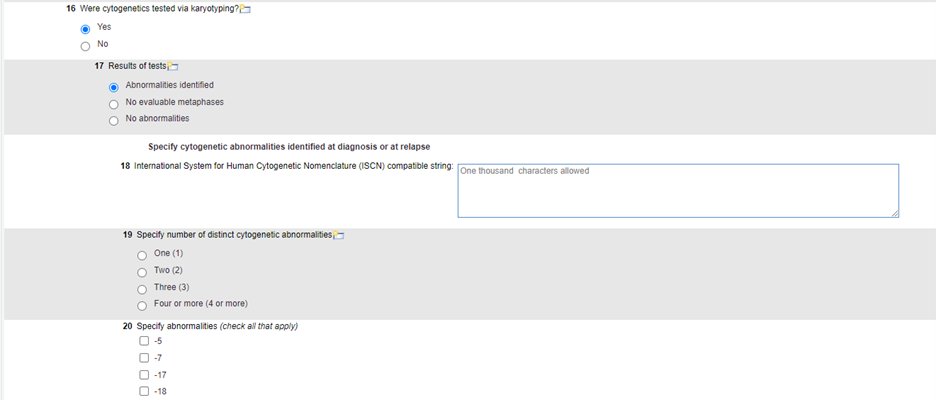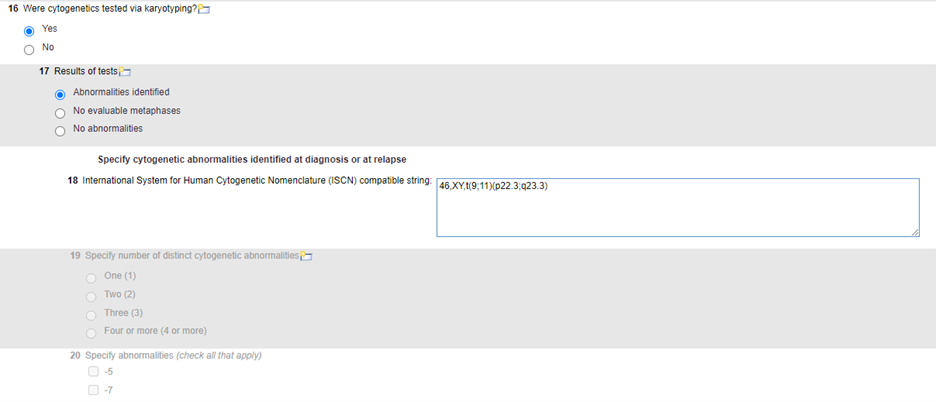Valid ISCN Compatible String
Depending on the lab used, karyotype results may not be structured using the ISCN nomenclature. Additionally, karyotype results may have an error or typo, causing the karyotype string to not be valid within ISCN nomenclature.
For the karyotype to be a ‘valid’ ISCN compatible string, the karyotype results should contain the following:
- The total number of chromosomes detected
- Sex chromosomes
- Abnormalities are denoted by a symbol or an abbreviation
- Each abnormality separated by a comma
- Parenthesis included when each abnormality specifies the location of the anomaly on the chromosome
- The parenthesis should include an ‘open’ and ‘closed’ parenthesis
- The number of cells with abnormalities, enclosed in brackets
- The brackets should include an ‘open’ and ‘closed’ bracket
- Spacing
- When a symbol or abbreviation immediately precedes or follows a parenthesis, a space is not used (i.e.,
47,XY,del(7)(q21q34),+8,t(8;9)(q13;q34)[20]) - When > 1 symbol or abbreviation is used together, each symbol / abbreviation is separated by spaces (i.e., psu dic)
- When the symbol or abbreviation is before the total number of sex chromosomes and parenthesis are not present, a space is used to separate the symbol / abbreviation from the number of sex chromosomes (i.e.,
mos 47,XXX[20])
- When a symbol or abbreviation immediately precedes or follows a parenthesis, a space is not used (i.e.,
Entering the ISCN Compatible String in FormsNet3SM
If karyotyping was performed the following questions will always be answered, regardless of the results:
- Were cytogenetics tested via karyotype and
- Results of test
Image 1. Questions always answered

The question Were cytogenetics tested via karyotype and Results of test will always be answered regardless of if the ISCN compatible string is entered or if the number of abnormalities and the specific abnormalities are reported
If karyotyping was performed and abnormalities were identified, then either of the following must be completed:
- The International System of Human Cytogenetic Nomenclature (ISCN) compatible string or
- The number of abnormalities identified, along with the specific abnormalities must be reported
If the ISCN compatible string is entered in FormsNet3SM, the number of abnormalities detected, and specific abnormalities identified data fields will be disabled in the system.
Image 2. Disabling of data fields
Use the following steps to enter the ISCN compatible string
- Copy the karyotype result from the karyotype report and paste into the ISCN compatible string data field. If the source karyotype document does not allow copy/paste, the ISCN string needs to be typed into the ISCN compatible string data field.
- The karyotype result entered must be a valid ISCN compatible string
- If the karyotype results are considered invalid, a FormsNet3SM error will occur, and the entered karyotype result must be corrected
- The FormsNet3SM error cannot be overridden
- Review Common Errors section below for an overview of common errors and corrections
- If FormsNet3SM error cannot be corrected, then remove the data entered in the ISCN compatible string data field, and select the number of abnormalities identified and the specific abnormalities detected
Section Updates:
| Question Number | Date of Change | Add/Remove/Modify | Description | Reasoning (If applicable) |
|---|---|---|---|---|
| . | . | . | . | . |
Need more help with this?
Don’t hesitate to contact us here.


